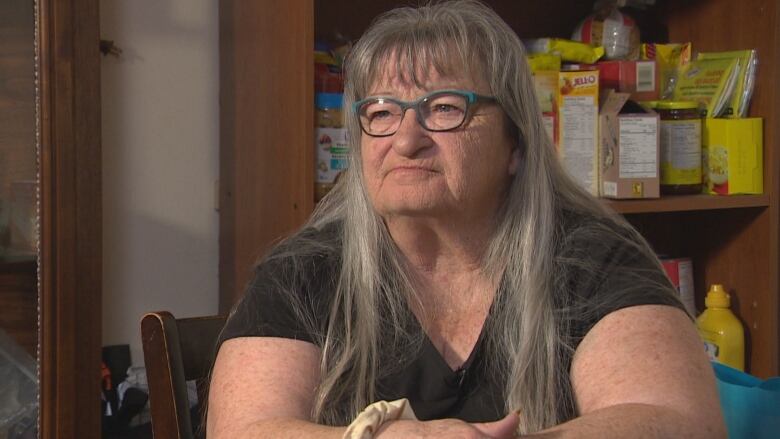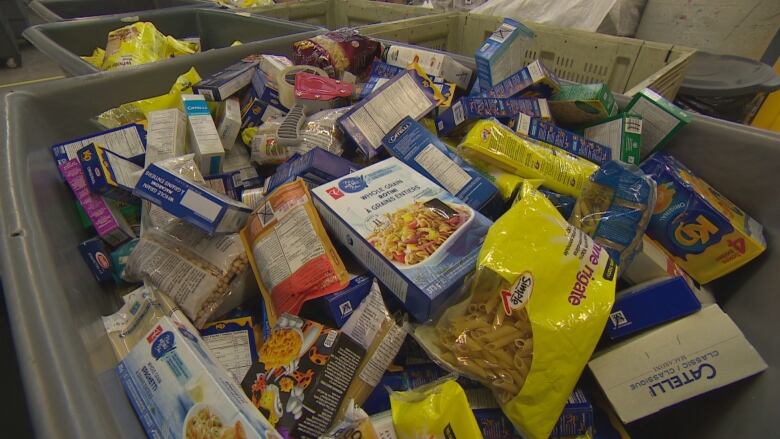Manitobans who use food banks face extra challenges if they also have a health condition
Nearly three-quarters of Manitoba food bank users can't afford healthy food, Harvest Voices 2023 report says

Three ways to help CBCand Harvest Manitoba to Make the Season Kind:
- Donation line:1-204-982-3581.
- Online.
- Drop offfood itemsat Harvest Manitoba, 1085 Winnipeg Ave.
Donation phone lines will be open until 7:30 p.m. Friday and for a short time Saturday morning, from 6-9 a.m. Online donations for the campaign will be accepted until end of day Sunday.
Nearly half of Manitobans accessing food banks are living with a disability or health condition, according to new data from Harvest Manitoba, an organization that supplies food banks across the province.
Its new Harvest Voices 2023 report also suggests nearly three-quarters of food bank users can't afford healthy food, making it especially hard for people to manage chronic health conditions.
That includes Sharon McCorrister, a retiree in Selkirk who's raising two young children and a teenager, with her husband.
Everyone in the household has special dietary needs, including allergies, autism, high blood pressure and diabetes.
"So at supper time, I cook three different things; at lunchtime, three different things," McCorrister said.
She spends up to $700a month on groceries, searching for sales and scanning clearance racks for affordable produce.
McCorrister relies on biweekly hampers from the Selkirk Food Bank for other staples, such as flour, pasta and canned goods.
"I've got to start a week ahead of time, thinking of my routes and what I'm gonna get and how much I have to spend," she said.
McCorrister's husband has diabetes, which keeps him from working, leaving the family of five without much more income than her old age pension.

Their limited budget means they often go without the healthier, sugar-free and whole food options recommended for people with diabetes.
"He'll have his fruits and vegetables," said McCorrister, who said much of that food comes from a can.
"Even if it does have sugar, he'll take a chance or he'll just eat half of itto save money."
She said the family rarely eats whole grains, which are rich in fibre and can help control diabetes. The cheaper but more highly processedwhite varieties of carbohydrates can send blood sugar soaring.
A scan of thegrocery store shelves in Winnipeg reveals products such as whole wheat pasta and bread can cost as much as three times more than the regular, white flour varieties.
A nutritionist from the University of Manitoba says higher costs for healthy food can make managing chronic illnesses like diabetes a struggle for people living on social assistance.

"I think it would be almost impossible to meet those needs," said Natalie Riediger, associate professor with the department of food and human nutritional sciences.
"You don't have any control when you go to a food bank," she said. "There's no way to plan, so people are victim to whatever is available."
RiedigersaidManitoba has some of the highest rates of diabetes in Canada, with close to a third of residents living with diabetes or prediabetes.
The province also faces one of the higher prevalences of food insecurity in the country, and many poorer neighbourhoods are food deserts, where healthier options are often not available, even at a food bank, she said.
"Food insecurity can lead to consuming foods that individuals know themselves are not supporting their disease management," Riedigersaid. "So there's a lot of stigma and shame for people in that situation, trying their best to manage it."
Harvest Manitoba says it occasionally offers things such as whole grain pasta and bread, but only when those items are donated.

The food bank distributor says when it purchases products in bulk, it buys the white variety of carbsto make the most of its limited budget.
Harvest Manitoba said people with special dietary needs should inform their local food bank, and it'll try to accommodate them as best as it can.
Some 73 per centof the 507 people who took part in the Harvest Voices 2023 survey said they can no longer afford healthy food, while 43 percentsaid they're living with disabilities or health concerns, which in most cases limit their ability to hold down a job.
"You learn to live with it," said McCorrister, who said making her own perogies, cabbage rolls, bannock and soups is key to feeding her family on a tight budget.
"If I hadn't learned how to cook from my mom, I probably wouldn't survive today on what the prices are."
Harvest Manitoba says the province has seen a 15 per centrise in grocery prices in 2023.
It reported a 150 per centincrease in food bank clients since 2019, including a 30 percent spike in the past year alone.













_(720p).jpg)


 OFFICIAL HD MUSIC VIDEO.jpg)
.jpg)



























































































